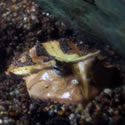Dangerous Frogs: Pretty Poisons

Frogs That Use Color—and Poison—to Warn Off Predators
 Frogs and other amphibians are prey for many other animals—birds, mammals, reptiles, fish, and even other amphibians rely upon these animals as a food source. Amphibians’ ability to live both in water and on land greatly increases the range of predators that depend on them for food. Yet amphibians have managed to survive for millions of years. To protect themselves, these animals have developed several survival strategies enhanced by coloration:
Frogs and other amphibians are prey for many other animals—birds, mammals, reptiles, fish, and even other amphibians rely upon these animals as a food source. Amphibians’ ability to live both in water and on land greatly increases the range of predators that depend on them for food. Yet amphibians have managed to survive for millions of years. To protect themselves, these animals have developed several survival strategies enhanced by coloration:
Many frogs, for instance, are so poisonous that predators have learned to avoid them.
Behavior: The First Clue
Which types of frogs make tasty prey and which are potentially lethal? The first clue is behavior.
Most frogs are nocturnal, or active at night, and use their surroundings to hide themselves, to avoid predators. But not all frogs hide for protection. The Ornate Horned Frog (Ceratopphyrs ornata), above, for instance, buries most of its body in the soil or leaf litter, exposing only its enormous jaws—the trap is set. Their color and form lets them blend into the environment to fool their prey.
Frogs that are poisonous, instead of hiding in their surroundings, tend to move about in the open and often are diurnal—that is, active during the day.
Coloration: The Second Clue
Frogs use three types of coloration. All help the animals survive, but each in a different way.
Protective coloration acts as camouflage, helping animals blend into their surroundings. Most frogs are green, brown, or gray—colors that are common in nature. This protective coloration is known as crypsis, or cryptic coloration. Many frogs and toads can change the color of their skin to blend into their habitats.
Flash coloration is kept hidden until the animal is under attack. The animal then flashes its bright colors to distract and confuse predators, thus helping the animal escape. The Red-eyed Treefrog (Agalychnis callidryas) uses its red eyes to shock and distract potential predators.
Warning coloration (or aposematic coloration) is the opposite of protective coloration. Bright colors on the upper surface of a frog’s skin usually mean that the frog is poisonous. Predators that attack a brightly colored frog quickly learn to avoid similar-looking ones in the future.
The Color of Poison
Some frogs don’t need to hide or blend into their surroundings. In fact, they advertise their location! Bold colors and wild patterns on the upper surface of the skin usually mean the frog is dangerous. These warning signs, called aposematic patterns, are a signal to predators that the frog is harmful. Aposematic comes from the Greek words apo-, meaning away from, and sema, which means sign—essentially, a sign to stay away from or to not eat.
In general, yellow, red, orange, and blue are aposematic colors in the wild, but aposematic patterns do not have to be colorful. In fact, high-contrast black-and-white patterns (as seen in the species Leptobrachium nigrops) are more effective in low-light conditions—a perfect way to alert nocturnal predators who cannot see color anyway.
Aposematic patterns often appear on the back and belly of the frog, or in the case of poison frogs, over the entire body. The Blue Poison Dart Frog is a good example of a frog that uses coloration as a warning. These frogs, found in the rain forests of Suriname, in South America, are bright blue, with black spots covering the back. By advertising their poison rather than hiding or blending into their surroundings, these frogs can more freely move about and forage during daylight without fear of predators.
This site explores four poisonous frogs:
- the Monkey Frog,
- the Golden Poison Dart Frog,
- the Blue Poison Dart Frog, and
- the Dyeing Poison Dart Frog.
For more information, visit the Rainforest Conservation Fund.